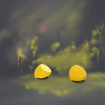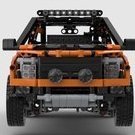Search the Community
Showing results for tags 'Power Functions'.
Found 368 results
-

[HELP] Power Functions BT Receiver
codefox421 posted a topic in LEGO Technic, Mindstorms, Model Team and Scale Modeling
I've put together an open source solution for controlling Power Functions using Bluetooth. Back when I started this, I had heard of the upcore, but it promised to be expensive and do a lot more than necessary. (Now that project doesn't even seem to exist anymore.) I've designed more of a 1:1 replacement for the standard PF IR receiver. Go here to find all the delicious source files: https://github.com/Btbricks Reading the readme can help in getting started: https://github.com/BTbricks/brickster-bluetooth-receiver/blob/master/README.md Here is a video of a very early prototype: I've built an Android app that looks just like the Power Functions remotes: I'd love to hear your thoughts about different app designs that could be useful. The cost per device is about $26. Everything squeezes into the inside of a theoretical 3x4 brick. I'm working on designing an enclosure (read: flashy plastic box), so please tell me what you would be looking for in terms of how it integrates with other LEGO bricks. Thanks! P.S. I'm trying to keep things licensed under an MIT license as much as possible. It is the most open of open source licenses! P.P.S. This topic is maybe inadequately named now.- 130 replies
-

Offroad Vehicle Design bible
Zerobricks posted a topic in LEGO Technic, Mindstorms, Model Team and Scale Modeling
I started this project because I wanted to share my experiences building various offroad models over the last decade. This topic is meant to guide the builders with comparisments, suggestion and best building practices, It is however not a place to find already finished and perfected designs - that's up to you. Various aspects of the design of the vehicles will be split into several subgroups and explained in details. 1. Number of wheels First thing we need to know is how many wheels our design will have. Most common setups are as following: 4x4 Setup Advantages: 1. The simplest and most widely setup 2. Having only 4 wheels means lower weight and higher performance 3. Higher manoeuverability 4. Simple suspension and driveline design Disadvantages: 1. With only 4 wheels the suspension has to be designed to be as flexible as possible to get the most out of the wheels 2. In a case of a mechanical failure of a single wheel, the whole model's performance is greatly affected 6x6 Setup with double rear axles Advantages: 1. Two rear axle provide more traction area, especially when going uphill 2. Usually 6x6 vehicles are longer than 4x4 and therefore less likely to tip over 3. Since the front and second axle are usually closer than in 4x4 setup, there is less ground clearance needed between them 4. Greater redundancy in a case of a mechanical failure Disadvantages: 1. Lower manoeuverability due to a longer wheelbase even with rear wheel steering 2. More complex driveline and suspension design is required 8x8 or more wheels setup Advantages: 1. Having 8 or more allows for much greater traction area 2. Ability to drive over ditches 3. Because wheels are usually much closer there is much less chances of getting stuck on top of an obstacle 4. Excellent redundancy in a case of a mechanical failure 5. Better weight distribution 6. Less suspension travel required per each wheel as with 4x4 or 6x6 and hence better stability Disadvantages: 1. Lower manoeuverability even with rear wheel steering 2. Powering 8 or more requires a very complex driveline 3. Depending on a driveline, combined torque required for powering all 8 wheels can destroy gears if a single wheel gets stuck 2. Type of wheels and tyres Now that we decided on how many wheels we want for our offroad beast, we have to look into what type of tyres and wheels we want to use. I will hereby cover only the bigger types of tyres and wheels. 1. 94.8x44R Advantages: 1. Low weight 2. Good thread design 3. Low rolling resistance Disadvantages: 1. Low traction, these tyres are prone to slip on the rim at high loads 2. Due to its rounded shape the tyres tend to slide off obstacles when crawling over them 2. 94.3x38R Advantages: 1. Low weight 2. Medium traction 3. Low rolling resistance 4. Realistic design and proportions Disadvantages: 1. Shallow thread pattern 2. These tyres are very hard and don't adjust to the terrain 3. 107x44R Advantages: 1. Low weight 2. Medium traction 3. Very deep thread 4. Currently largest tyres by diameter Disadvantages: 1. High rolling restistance and vibrations due to the thread pattern 2. These tyres are a bit hard and don't adjust to the terrain 4. Power Puller tyres Advantages: 1. High traction 2. Good thread 3. Largest Lego tyres ever produced 4. Deep wheel offset Disadvantages: 1. High weight 2. Hard to use, they require complex hub assemblies 3. Very rare and expensive 5. Outdoor challenger wheels Advantages: 1. Very high traction 2. Very good thread pattern 3. Deep wheel offset 4. Over 7 studs of space inside the wheel Disadvantages: 1. High weight 2. Hard to attach to the standard axles 3. They require a lot of torque to use them at their full potential. 6. Tumbler wheels Advantages: 1. Low weight 2. High traction 3. Very flexible Disadvantages: 1. Low thread pattern 2. Small size 3. Expensive For the 94.8x44R. 94.3x38R and 107x44R tyres we have a choice of two wheels: 1. Racing wheel large Advantages: 1. Good mounting option with axlehole and pinhole 2. Available in multiple colours 3. Cheap Disadvantages: 1. No inside wheel offset means steering pivot point can't be placed inside the wheel. 1. Futuristic wheel Advantages: 1. Deep wheel offset allows us to place steering pivot point inside or closer to the wheel than racing wheel large 2. Slightly larger wheel size stops the 94.8x44R tyre from slipping on the rim Disadvantages: 1. Limited mounting options, with only one axlehole 2. Hard to find 3. Hubs Now that we have our wheels and tyres we need a way to mount and power them. Here are the most common currently available options: 1. New standard ungeared CV hubs These hubs are usually driven by the CV joint counterpart which pops inside Advantages: 1. Low steering pivot offset - usually at the edge of the tyre: 2. Firm wheel mounting 3. Readily available, easy to use and to build on. Disadvantages: 1. Low operating angle - the CV joint can operate to a maximum of about 30 degrees, which limits steering angle. 2. Very low torque transfer - the CV joints are prone to deforming and popping out even with low torque applies to them 3. Low ground clearance 2. Old ungeared CV hubs Advantages: 1. Low steering pivot offset - usually at the edge of the tyre 2. Firm wheel mounting 3. Better ground clearance than newer hubs Disadvantages: 1. Very low operating angle - the CV joint can operate to a maximum of about 25 degrees, which limits steering angle. 2. Very low torque transfer - the CV joints are prone to deforming and popping out even with low torque applies to them 3. Hard to find and expensive 4. No other mounting points than 4 ball joints 3. Built cardan ungeared hubs Example of a hub using a cardan joint to directly transfer the power to the wheel Advantages: 1. Low steering pivot offset - usually at the edge of the tyre 2. Easy to build 3. Can transfer higher torque than a CV joint 4. Higher steering angle Disadvantages: 1. Mounting relies only on the axle and is not as firm as standard hubs 2. Not capable of transferring high torque to the wheels 3. Low ground clearance 4. Standard portal hubs Advantages: 1. Easy to use and to build on. 2. Can transfer very high torque to the wheels when using 8z and 24Z gear combination 3. High steering angle 4. High ground clearance 5. Firm wheel mounting Disadvantages: 1. Very high steering pivot offset - requires stronger steering mechanisms and more fender space for wheel to swing 5. Built portal hubs Advantages: 1. Easy to build. 2. Can transfer very high torque to the wheels when using 8z and 24Z gear combination 3. High steering angle 4. Higher ground clearance than standard portal hubs 5. Low steering pivot offset when using futuristic wheels Disadvantages: 1. Wheels are mounted and held only by one axle, not as firm as standard hubs 2. Hub relies on friction of the components to keep it together, which can slide apart after prolonged use 6. Built planetary hub Advantages: 1. Highest gear ratio of all other hubs, 1:4 2. Firm wheel mounting when using futuristic of power puller wheels 3. High steering angle 4. Lower steering offset than standard portal hubs Disadvantages: 1. Requires old turntable, futuristic or power puller wheels for best results - all are hard to find 2. High number of moving gears 3. Least efficient due to the high friction caused by the large surface contact area and number of moving gears 4. Suspension Suspension is the mechanism that will keep our model's wheels in contact to the ground and will be supporting most of its weight. Most of the designs cover 4x4's Following factors determine the type of suspension system we will use: 1. Weight of the model - The heavier the model, the stronger the suspension components have to be 2. Speed - Faster models require more responsive suspension systems with low unsprung weight 3. Flexibility - The higher the obstacles you want to climb over the more flex and/or wheel travel suspension has to provide 1. No suspension I have yet to see and offroad vehicle without any type of suspension (except for maybe 42070, 42081 and 42082), but I will list my opinion regardless: Advantages: 1. Simple design - having no suspension simplifies our design...and that's about it Disadvantages: 1. No flex over terrain means, there are only 3 wheels at once touching the ground 2. Low stability 3. Poor weight distribution 4. No shock absorption at high speeds 2. Pendular suspension This is the simplest suspension you can put on your vehicle. It basically means one or more of your axles are free to swing about. When using this suspension I suggest using the small turntable where drive axle enters the axle. This will keep the drive axle from carrying the weight of the model, which causes unnecessary friction. 42030 is a typical example of this suspension system. Advantages: 1. Simple, robust design 2. Using this suspension on both axles can give the model very high flexibility 3. If there are no springs used, the model can have perfect weight distribution on left and right wheel Disadvantages: 1. Large unsprung weight, poor responsivness at high speeds 2. No shock absorption means this suspension is not suitable for high speeds 2. When using on one axle, the stability of the whole model relies on the unsuspended axle. 3. When using pendular suspension on both axles springs or a transfer mechanism are required to keep the model upright 3. Single torque tube suspension This suspension became available with the release of the 8110 Unimog. Best examples of this suspension are 8110, 9398 and 41999. It is the simplest suspension which also allows for vertical suspension movement. Advantages: 1. Simple, robust design 2. Universal joints can be placed inside the ball joint, allowing power to be transferred to the axle 3. Easy to implement Disadvantages: 1. Large unsprung weight, poor responsivness at high speeds 2. Axle requires a some kind of a linkage system to keep it cenetred (panhard or parallel links as seen above). 3. Using this suspension on the front axle usually results in negative caster angle which causes higher rolling resistance 4. When used on rear drive axle, the suspension has the tendency to cause oscillate, especially with soft suspension and high power 4. Hard to connect springs to the chassis 4. Double torque tube suspension This is an evolution of the single torque tube suspension, which uses two ball joints to drive each wheel side respectively. It is my own original idea. Advantages: 1. Simple, robust design 2. Universal joints can be placed inside the ball joint, allowing power to be transferred to the axle 3. Easy to implement 4. Self-cenetring, since axles are connected in the center there is no need for linkages to center it 5. Can carry power to each wheel side independently 6. Drive torque compensation Disadvantages: 1. Large unsprung weight, poor responsivness at high speeds 2. Using this suspension on the front axle usually results in negative caster angle which causes higher rolling resistance 3. When used on rear drive axle, the suspension has the tendency to cause oscillate, especially with soft suspension and high power 4. Hard to connect springs to the chassis 5. Parallel floating axle This suspension uses linkages which keep the axle parallel to the chassis of the model. For best functionality and reliability the lengths of all links and that of the double cardan joint should be equal. Also all the linkages and drive axles should be parallel. Advantages: 1. Keeping the axle parallel to the chassis reduces the oscillations effect 2. Better responsivness compared to the torque tubes 3. Neutral caster angle when used on front axles. 4. Self cenetring when using A arm as upper link or 4 link setup 5. Can be configured to carry power to each wheel side independently 6. If configured to carry power to each wheel side independently the drive torque can be compensated. 7. Easy to connect spring to the chassis Disadvantages: 1. High unsprung weight, less responsive at high speeds 2. Increased mechanical complexity, double cardan joints required to carry the power to the axle 6. Half axle independent suspension This is the simplest independent suspension you can build. Best example of such suspension are Tatra and Pinzgauer trucks. Advantages: 1. Independent suspension with low unspring weight, suitable for high speed 2. Robust design with low number of moving parts 3. Easy to connect spring to the chassis Disadvantages: 1. Changes of the caster angle as the wheels travel up and down 2. Hard to implement a drive system that does not carry the weight of the vehicle 3. Hard to implement steering system 4. Wheels tend to drag sideways on the ground when suspension travels up and down, reducing efficiency 7. Trailing arm parallel independent suspension Personally I have not used this suspension yet, but I did use a normal trailing arm suspension which does not keep the hubs parallel. Normal trailing arm suspension which does not keep the hubs parallel acts similarly to torque tube suspension. For the prallel version of the trailing suspension I imagine the following: Advantages: 1. Independent suspension with low unspring weight, suitable for high speed 2. Robust design with low number of moving parts 3. Long links allow for high suspension travel 4. Very easy to connect spring to the chassis 5. Can be configured to carry power to each wheel side independently Disadvantages: 1. Hard to keep the wheels from sagging under the weight of the model. 2. Difficult to transfer power to the wheels 8. Double wishbone suspension This suspension uses two A-shaped arms to keep the wheel hubs in place. As of late it's my favourite suspension system due to: Advantages: 1. Independent suspension with low unspring weight, suitable for high speed 2. Very customizable design with lots of adjustable characteristics (suspension arm lengths, caster angle, camber angle, steering geometries) 3. When build correctly it is far more robust than live axle suspension 4. Increased ground clearance compared to live axle suspension, especially when used with portal hubs 5. Can be configured to carry power to each wheel side independently 6. Extremely easy mounting of springs 7. Very stable compared to live axles 8. Frame holding the suspension can be part of the chassis, therebye lowering the center of gravity Disadvantages: 1. More moving parts as live axle suspension, increased mechanical complexity 2. Limited wheel travel - Lego wishbones allow a max. of around 25 degrees of suspension angle 9. Multi-link suspension To be updated when I build my first multi-link offroad suspension. I can assume the following characteristics: 1. Independent suspension with low unspuing weight, suitable for high speed 2. Extremely customizable design with lots of adjustable charactersitics (suspension arm lengths, caster angle, camber angle, steering geometries, virtual pivot point) 3. Large steering pivot point compensation 4. Increased ground clearance compared to live axle suspension, especially when used with portal hubs 5. Can be configured to carry power to each wheel side independently 6. Very stable compared to live axles 7. Frame holding the suspension can be part of the chassis, thereby lowering the center of gravity Disadvantages: 1. Very high amount of moving parts, increased mechanical complexity 2. Limited wheel travel - Lego wishbones allow a max. of around 25 degrees of suspension angle 3. Hard to connect springs to the chassis 10. Spring types Listed below are the most common types of springs available: 6.5L Soft shock absorber Advantages: 1. Small, easy to implement Disadvantages: 1. One stud of suspension travel 2. Low spring rate, can't support heavy models 6.5L Hard shock absorber 1. Small, easy to implement 2. High spring rate, can support heavy models Disadvantages: 1. One stud of suspension travel 9L soft shock absorber When using 9L shock absorbers I suggest you do not use the default offset upper attachment point, but use an in-line attachment point instead. This will reduce the friction and allow for better high speed performance Example: Advantages: 1. Two studs of suspension travel 2. More attachment possibilities than 6.5 L shock absorber Disadvantages: 1. Default attachment points create friction 2. Low spring rate, can't support heavy models 9L hard shock absorber Advantages: 1. Two studs of suspension travel 2. More attachment possibilities than 6.5 L shock absorber 3. High spring rate, can support heavy models Disadvantages: 1. Default attachment points create friction 2. Rare and expensive 11. Attaching springs to live axles If we start with basics, the first things we have to check is how position of springs affects suspension of live axles. The closer you place the springs together, the more flex the suspension will have, but it will also be less stable: I suggest you to keep springs at a distance of around 1/2 of the total model width. When placing springs you should keep them in-line with the wheel bearing in order to reduce friction. First example of bad spring placements: And example of good spring placement: When using multiple springs make sure to place them symmetrically centrred to the wheel hub: When attaching springs to torque tube suspension, you have to allow springs to tilt in two planes: You can also attach the springs to the suspension links to increase suspension travel. This technique is especially common on Trophy Trucks: 12. Attaching springs to independent suspension Independent suspension allows for much more flexible spring placement. Generally the closer you attach the spring to the main suspension arm pivot, the higher spring travel you get, but lower suspension force. Examples going from the hardest suspension with low travel to the softest with high travel: You can also attach springs inside the suspension arms: Or horizontally: As with the live axles make sure springs are in the center of the wishbones. Example of good placements: And an example of bad spring placement, which causes excessive friction and suspension binding: 5. Steering Steering is the system which allows our model to change direction. Generally there are two types of steering system used: 1. Skid steering Advantages: 1. Very simple to implement and control with two separate motors for left and right sided wheels. 2. Does not require a dedicated steering motor Disadvantages: 1. Not efficient, since wheels have to skid to steer 2. Power had to be reduced or even reversed in order to steer. 3. Not very accurate 4. Not very effective offroad 2. Classical steering with steerable wheels Advantages: 1. Efficient, with minimum loss of speed 2. Accurate 3. Does not reduce the power of the drive motors 4. Can be used in front, rear or all axles for tight steering radius or crab steering 5. Effective offroad Disadvantages: 1. Requires more complex hub assemblies 2. For best steering accuracy you need a dedicated servo motor. Examples of a simple classical steering system for live axles 1. Parallel steering system for live axles Here both hubs are always parallel. Position of the steering in the front or rear rack has no affect on the steering. Advantages: 1. Very simple and robust 2. Easy to build Disadvantages: 1. No Ackermann steering geometry 2. Steering rack moves inwards as it steers, requiring more space. 2. Ackermann steering system for live axles This system allows the hubs to steer at different rates. The steering arms are offset inside so they form a virtual steering point where at the point where lines meet. Advantages: 1. Better steering performance Disadvantages: 1. More complex assembly 2. Steering rack moves inwards as it steers, requiring more space. 3. Steering system with diagonal linkages This system acts similar as Ackermann steering system by using diagonal steering links. Advantages: 1. Better steering performance 2. Steering rack only has to move in one direction without sideways movements 3. Can be configured to be used in front or the rear of the axle. Disadvantages: 1. More complex assembly 4. Simple steering system for independent suspension 1. Very simple and robust 2. Easy to build 3. Can be even more robust when using double steering racks and links 4. Steering rack only has to move in one direction without sideways movements Disadvantages: 1. No Ackermann steering geometry 5. Ackermann steering system for independent suspension Advantages: 1. Better steering performance 2. Steering rack only has to move in one direction without sideways movements Disadvantages: 1. More complex assembly, less robust. 3. General steering tips 1. When using independent suspension always make sure your links are paralel to the suspension arms, otherwise you may end up with wheels which are not parallel and are causing excessive friction: 2. When using standard portal hubs make sure your steering system is robust enough to deal with the forces generated by wheel driving into obstacles. 3. If possible use servo motors which allow for high steering precision and return to center. They are especially useful at high speed models. 4. Most efficient way to steer the wheels is using the steering racks. 5. Build axles in such way they have positive caster angle, example for direction of travel from right to left. This will self-center your wheels and reduce rolling resistance. 6. Drivelines Drivelines are the responsible for transferring the power from the motors to the wheels. There are various drivelines you can build, here I listed few with their characteristics: Driveline types 1. Permanent 4x4 Advantages: 1. Simple, centralized, low mechanical complexity 2. Wheels are always powered, great offroad performance 3. Light weight Disadvantages: 1. Poor steering radius 2. Tyres have to skid when steering, lowering efficiency of the model 2. 4x4 with open differentials Typical example of this driveline is 42070 Advantages: 1. Differentials allow the wheels to so spin at different rates when steering 2. Very efficient since wheels don't have to skid when steering Disadvantages: 1. If one wheel loses traction, all the power is transfereed to it, poor offroad performance 3. 4x4 with lockable differentials Advantages: 1. Differentials allow the wheels to so spin at different rates when steering 2. Very efficient since wheels don't have to skid when steering 3. All differentials can be locked, so wheels are powered for great offroad performance Disadvantages: 1. Higher mechanical complexity 2. Dedicated motor is required to actuate differential locks, higher weight 4. Axle mounted motors Typical example of this driveline are 9398 and 41999. Advantages: 1. Differentials allow the wheels to so spin at different rates when steering 2. Very efficient since wheels don't have to skid when steering 3. If one wheel gets off the ground the second axle can still pull/push the model. Disadvantages: 1. Higher mechanical complexity 2. Usually the rear axle motor is more loaded than the front, especially when climbing uphill, the motors can't "help" each other. 3. Worse offroad performance than permanent 4x4 5. H drive: This is my favourite driveline due to the following reasons: Advantages: 1. Motors allow the wheels to so spin at different rates when steering 2. Model can skid steer 3. Very efficient since wheels don't have to skid when steering normally 4. Having 2 drivelines allows you to carry more torque to the wheels 5. Redundancy, even if one drive fails the model can still move 6. Wheels are always powered, great offroad performance Disadvantages: 1. Higher mechanical complexity 2. Slightly higher weight 6. Wheel motor drive Each motor powers a wheel independently. Advantages: 1. Motors allow the wheels to so spin at different rates when steering 2. Model can skid steer 3. Very efficient since wheels don't have to skid when steering normally 4. Redundancy, even if one or more motors fails the model can still move 6. Lower mechanical complexity Disadvantages: 1. Motors can't "help" each other 2. Higher weight due to a higher motor count Transferring power axially When transferring power via axles, you can reduce the flex by using connectors instead of simple "bare" axle: Use axles with stops to prevent them from sliding out of gears: Where possible always brace tooth gears from both sides: Transferring power at an angle Where pairs of U joints are used, make sure to align them to eliminate vibrations: Brick built CV joint which can transfer high torque at over 30 degrees angle Brick built cardan joint which can transfer extremely high torque up to 15 degrees angle Brick built flexible drive which can transfer medium high torque, extract and retract, suitable for low angles Transferring power perpendicularly The following perpendicular gearboxes are the best suitable for transferring high torque Avoid knob and worm gears, because they waste energy Gearboxes In my models I generally use the following gearboxes: 1:3 differential gearbox Advantages: 1. Very high gear ratio between low and high gear, 1:3 2. Capable of transferring high torque 3. Very efficient since only 2 gears are used at any time Disadvantages: 1. Takes a lot of space 2. This gearbox requires a good housing to brace the gears properly Compact two speed gearbox Advantages: 1. High gear ratio between low and high gear, 1:2,77 2. Capable of transferring high torque 3. Very efficient since only 2 gears are used at any time 4. Very compact design Disadvantages: 1. Requires two of the rare 20 tooth clutch gears 2. More complex shifter assembly. Diagonal gearbox Advantages: 1. High number of gears 2. High gear ratio possible, over 4:1 2. Capable of transferring high torque 3. Very efficient since only 2 gears are used at any time Disadvantages: 1. Takes a lot of space 2. Input and output axles are not parallel. 3. A complex shifting assembly is required for sequential operation. Driveline effect on suspension Transferring torque on the wheels can affect the suspension, especially when live axles are used. The following photo shows how the torque causes one side of the axle to push down and the other to lift up: In order to minimize this effect I suggest the following: 1. Make sure to have most if not all the downgearing inside the axles, so you do not need high torque going to the axles. 2. Make sure your models have a low center of gravity 3. You can eliminate this effect by using two counte rotating axles which cancel each other's torque, example below: 7. Motors and control Following are the most common types of motors used for Lego models. You can find more info here: http://www.philohome.com/motors/motorcomp.htm My personal favourites are L and RC motors due to the balanced output speed to torque ration and great mounting options. 1. PF-M Advantages: 1. High speed output 2. Smallest available motor 3. Cheap and available Disadvantages: 1. Low torque 2. Poor mounting options 2. PF-L Advantages: 1. High speed output 2. High torque 3. Cheap and available 4. Great mounting options Disadvantages: 1. Odd shape 3. PF-XL Advantages: 1. Very high torque 3. Cheap and available 4. Good mounting options Disadvantages: 1. Slow speed output 2. Large form factor 4. PF-Servo Advantages: 1. Very high torque 2. Very precise output with 15 positions 3. Good mounting options Disadvantages: 1. Slow speed output 2. Output axle can move a max of 180 degrees 3. Large form factor 4. Hard to find 5. 9V-RC motor Advantages: 1. Most oowerful Lego motor 2. Very high speed output 3. Good mounting options 4. Two output axles with different gearing ratios 5. Drive axles can pass through the motor Disadvantages: 1. Low output torque 2. Low efficiency 3. Power hungry 4. Odd form factor 5. Hard to find and expensive Power options 1. PF - AA battery box Advantages: 1. High capacity 2. Good mounting options 3. Works with rechargeable batteries, but with lower performance 4. Cheap and easy to find Disadvantages: 1. 750mA current limit - not enough to fully power RC motor 2. Heavy 3. Has to be removed and opened to replace batteries 4. Wasteful 5. Odd form factor 2. PF - LiPo battery box Advantages: 1. Small form factor 2. Light weight 3. Easy to recharge Disadvantages: 1. 750mA current limit - not enough to fully power RC motor 2. Low capacity 3. Studded design 4. Expensive and hard to find 3. RC control unit Advantages: 1. No current limit - can power 2RC motors at once 2. 3 Power levels 3. Has integrated steering output with 7 positions 4. Good mounting options 5. Easy battery replacement 6. Radio based control Disadvantages: 1. Poor quality, prone to breaking 2. Limited angle (45 degrees) and torque from the steering output 3. Has to be removed and opened to replace batteries 4. Very large form factor 5. Expensive and hard to find 6. Heavy 7. Required dedicated antennas and remote Control options 1. PF receiver and controller Advantages: 1. Receiver is easy to integrate into the model 2. Controllers have physical feedback 3. Cheap and easy to find Disadvantages: 1. IR based, low range, useless outside 2. Lack of PWM motor control, unless using train controller which is awkward to use 3. Odd form factor for use with steering 2. RC control unit See above 3. Third party options such as BuWizz and Sbrick Advantages: 1. Smaller form factors, easy to integrate into model 2. More outputs than PF system 3. Smooth control of motors 4. High range thanks to Bluetooth control 5. Higher power available with BuWizz 6. Customizable profiles Disadvantages: 1. Smart device is required 2. No physical feedback 3. Sbrick is limited by PF battery box 4. Price 8. Chassis Chasis is the backbone of your model which olds everything together. For chassis I suggest you to use the following components in order to make it strong and robust enough to deal with the stresses involved when crawling or driving at high speed: Some flex in the chassis might be a good thing to improve offroad capability, but only if id does not affect the driveline and cause friction on the drive axles. Remeember to use diagonal support, since triangles are the strongest shapes. You can also use panels and motors as structural support. Interlocking your chassis will keep it from slipping apart. For good examples of chassis designs I suggest you check the instructions for 9398 and 42083.- 35 replies
-
- power functions
- cv
- (and 16 more)
-

[APP] BrickController2
imurvai posted a topic in LEGO Technic, Mindstorms, Model Team and Scale Modeling
BrickController2 is an Android and iOS application that allows you to control your Lego models using a compatible gamepad. It supports the following devices: - SBrick - BuWizz 1-2 - BuWizz 3 (basic support) - Lego Powered-Up devices: Boost, PUP HUB and Technic HUB (or Control+) - PF infrared (on Android devices having infrared emitter). Features: - Multiple profiles for a single creation - Multiple motor (or output) assignment to a single controller event - Different types of devices can be used at the same time - The same motor (or output) can be assigned to multiple controller events - Different joystick characteristic settings - Different button modes: normal button, simple toggle, ping-pong toggle, carousel toggle, ... - Train mode on joysticks - Normal and servo mode for the new Control+ motors - Sequences (like for flashing light) BrickController 2 on the Google Play Store: BrickController2 android BrickController 2 is also available on the Apple App Store. BrickController2 iOS Video tutorial created by @kbalage (many thanks for this): And another great video by @kbalage: Older versions: BrickController Android application. It lets you to control Lego creations via Lego infra-red, SBrick and BuWizz V1 and V2 using any Android compatible game controller: Current version: BrickController 0.6 User guide: BrickController User Guide Minimum system requirement: Android 4.4 and bluetooth low energy support on the phone (or tablet) Video on the older SBrickController application:- 1218 replies
-
- android
- powered up
-
(and 8 more)
Tagged with:
-
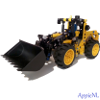
Optimus Prime G1 Transformer (version 1.0)
Appie posted a topic in LEGO Technic, Mindstorms, Model Team and Scale Modeling
I made this last year and didn't get around to make a topic about it until now. A video of it transforming: The model weighs 1.6kg and most of that is on the front axle. I haven't been able yet to make a mechanism that will allow Optimus to lift himself without a "hand of god" Some more photo's The rope you see between the front wheels in the photo above is what makes the flaps with the headlights at the front besides the grill fold back when Optimus is standing, but flex (thanks to rubberbands) when the hands need to be folded back into the body when he's transforming into a truck. The little grey wheels you see at the rear wheels make the black rear wheels barely touch the ground, this helps the leg spread mechanism. Speaking of which, the clicking in the video comes from these 2 mini-LA's in the legs: They make Optimus spread his legs a little when he's standing. I thought that looks better than him simply having his legs straight when standing, but the gearratio is off. If I manage to make a mechanism for the legs that works in lifting the model on its own then I might be able to tackle this gearratio too. In case somebody wonders where I put the battery box, it's external Thanks for taking the time to read my topic, hope you enjoyed it. If you have any questions, feel free to ask.- 9 replies
-
- power functions
- transformer
-
(and 1 more)
Tagged with:
-
Update october 2023: After abandoning this MOC about 7 years ago, I felt it was time to revisit it after years of brewing ideas to make this work. I am getting close to a full functional model, but not sure I can eliminate the last few issues completely. Currently the transformation works flawlessly, drive works, brake flaps work, steering wheel in the cab works, actual steering works somewhat, 360 turning works somewhat. The problems with steering is mainly in the arms for the wheels, the part above the wheel with the small turntables has too much flex, I need to tackle this while trying to keep the look of the arm as close to the source material as possible (and I already took some liberties there as you can see). It houses 2 XL for drive. There is 1 wheel at the front under the cockpit and one behind the exhaust each with their own XL. A concept was made to put the motor besides the wheel, like how the "real" model has an electro motor there, but it gave similar problems like the steering arm flex problems. 2 L- motors to steer these wheels 4 L-motors to steer the wheels at each arm 1 L-motor to act as a switch for "360" turning with 3 PF switches it inverts 1 drive motor, 1 steering arm motor at the rear and 1 at the front. I also use this setting to turn the wheels close to completely sideways for the transformation (I didn't do this in the picture above) 1 Servo for the brake flaps 2x (train) battery boxes. Also to be clear: the arms do not carry the weight of this model. I cheated, those 2 wheels for drive under the model+4 bogey wheels placed directly under the battery boxes carry the weight. One of my biggest mistakes from 8 years ago, was thinking Lego could handle this, so that was abondoned instantly for this. I also figured it would be nice to have a vehicle that's basically a tank, build like a tank, so it has about 40 5x7 frames, flip-flop beams and I tried to secure every panel into position. This makes it very heavy, but quite sturdy. Special note to https://www.eurobricks.com/forum/index.php?/profile/21067-hass-kabal/ He made a system bricks model of this batmobile long ago (2015) and I used some of his solutions, like the wheel arches on the side of the front arms, the steering wheel in the cab and I pretty much sized up his "electro" motors on the inside of the wheels. I hope to make a video of the whole thing within the next month, but no promises More pics will probably happen sooner than that. Original post from 8 years ago: Hardly finished anything on this model, but felt like sharing the progress so far anyway. Building this is the goal: Here's a video which shows various functions of the batmobile in the game: I am planning to add the following functions: -2x XL motor for 4WD (I expect the total weight to be about 3-4kg, so I reckon I could use their power. I am a little afraid of breaking gears/axles, so still have L motors as a backup plan. -2 servo motors which are going to provide 3 ways of steering: Normal drive with airflaps to assist steering (as seen in the video) 360 degree turn on the spot (unfortunately not in the video but it can do this) Battle tank mode with crab steering -2 M motors for the turret and opening the cockpit for Batman to get in (I expect to add that function anyway besides the 2 functions I want for the turret) -9 PF lights, among which 1 set for the afterburner in "normal drive mode" I wanted to built this model since Januari, I even briefly considered it for TC7, but Jim and I both agreed that this vehicle fails the "looks like a normal car in non-battle mode" Meanwhile some other people on Eurobricks had a crack at the model (click en clicker) I liked the first topic alot for the CGI pictures of the batmobile like this, because seeing all the details on a model that's mostly black ingame is kind of hard. The fact that Warner Bros cancelled the version of the game that came with a scale model of the batmobile didn't help either, luckily these pictures also help for getting the scale right in the MOC. The second topic is pretty nice for some of his brickbuild solutions. An area I am not too familiar with since I built mostly Technic and lack knowledge of normal Lego parts. Two things I don't like about the second model: the wheels are too small (or the model too big for the wheels), especially shows around the wheelarches, but the wheelarches on my model are too thick too, but not as much as this one I think. The other thing is that he cut and drilled some parts to fit the model. I like to find solutions within the Lego system, so modding is a big no-no for me. Anywho, time for some pictures. It isn't much (not even in time invested, since I just did a little every moment I had time for it), but at least I can copy-paste to the other side instantly, assuming I don't have to make adjustments (as if lol) The midsection is just for me to get a rough idea of how it will look (leaning on a BB so it won't fall over). So it's lacking details just about everywhere in that section. Wheels and stuff missing some details too, but I want to get a functional model first. Every wheel needed to have 3 things: drive, steering and lights. The real model has electro motors on each wheel, I briefly considered mounting a M or L motor on the side and have it drive the wheel, but getting it locked in place there wouldn't look right with the actual model (wire of the L motor basically going over the inner tire). One thing I haven't looked into though is making my own rims for the tires, I will see how this works out first. The wires for the lights have been in many places and this is just about the only place where they don't interfere with the steering and driving gears. Here you can also see the main reason why my wheelarch is too thick: I needed 2 studs to fit those functions above the wheel. I am afraid the structure holding the wheels proves to be too weak for the full model, so might have to reinforce that later on. XL motor's spot is up for the debate. It will probably end 2 studs lower. Gear ratio at the moment is 1:1 (I think), not sure which way I am going to go with that since the XL is known to break gears and axles Battle tank crab steering mode. My model won't make 360+ turns with the wheels, nor even 180 degrees for 2 reasons - 360+ I am not feeling because of the wires getting tangled up - 180 degrees isn't going to really work with the servo. I want to use the servo for snappy steering like the real thing. The liftarm for the steering is a stud closer to the middle of the car than i'd like, but this was the spot to at least get a 100-120 degree turn. One servo will function as a gearbox between the different driving modes while the other servo just steers. I chose this setup to be able to switch quickly between steering modes, just like in the game. Lights had to be used on this model. I am still looking for a way to get the lights to turn red when he enters battle mode, but I don't know where or how (open for suggestions). The reason the rear doesn't have 3 lights on the wheel (does ingame), is because these are rarely shown (battle mode only, and only with the wheel at an angle). In case you wonder about some angles in this model. Pretty early in the build I lost track of what's 100% clean so I just began testing stuff by fixing a liftarm on 1 side and lining it up with the hole I wanted to use on the other end. If I could spin an axle freely in this hole, I gave it the thumbs up, if not, back to looking for another solution. One funny spot on the model where there is pressure, is at the rear, thanks to the freaking 12L soft axles, which quite frankly aren't acting so soft! If the soft axles aren't locked into to place the triangle above the rear lights aren't pushed into the 5x7 panles on the top, they push them slightly in when they are connected Some panels are only fixed in 1 spot, to give them room to move slightly around another panel/axle/liftarm if needed. I noticed a little late that some photo's are a little blurry, sorry, will check it next time. Next up: the actual chassis.
- 42 replies
-
- knight
- arkham batmobile
-
(and 4 more)
Tagged with:
-
Just began another baja/ trophy-truck project, the other 2 (or 3) being ”canceled”. I managed to put 2x L motors and 1x servo motor, both Power Functions; it also has positive caster-angle, independent suspension in front and solid axle suspension on the rear, (at least) semi-detachable body and the headlights can be be lit (there are 4 pin-holes for installing lights). Heavily modified version of this
- 81 replies
-
- power functions
- moc
-
(and 3 more)
Tagged with:
-
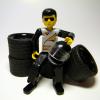
[MOC] RC Telehandler
legomarat posted a topic in LEGO Technic, Mindstorms, Model Team and Scale Modeling
After several years I am back! My latest MOC is Lego telehandler based on CAT TL642. Since it is not an exact reproduction I decided to change name and logos. Buwizz and iPad are used to control it remotely. There are four motorized functions: drive with PF L motor, boom elevation with PF L motor, fork tilt with M motor, and steering with PF servo. Front wheels are driven through a differential, and the rear axle has a simple suspension. Overall, it is maneuverable, easy to operate thanks to the proportional control of Buwizz, and very fun to play with. Please check out my flickr and https://www.flickr.com/photos/marat_andreev/ my instagram www.instagram.com/legomarat/ Interior controls are made with stickers Also I found a nice reflective sticky paper to make mirrors- 16 replies
-
- power functions
- technic
-
(and 2 more)
Tagged with:
-

Universal off-roader 4x4 V2
Zerobricks posted a topic in LEGO Technic, Mindstorms, Model Team and Scale Modeling
As soon as I saw the new parts in the 42159, I knew I just have to use them to upgrade the previous version of the Universal 4x4 off-roader. After tinkering for a few weeks in LDD, and actually building it IRL yesterday, it is officially finished: The V2 has a big list of upgrades comapred to V1. Dual independent drive, one for left and other for right wheels - allowing skid steering Two 3 speed gearboxes - that's right, this is my first off road vehicle with 3 gears for optimal performance Improved steering system - much more direct, accurate and responsive Highly modular design - easier access for maintenance and charging Top speed has been increased by 40% both in low and high gear - the previous version had ample torque, so I geared up all the ratios by 40% and added a middle gear Increased suspension travel at the rear - first time I'm using 11 studs long suspension arms Improved drive motor mounting - now they are no longer at a weird angle Similar part count to the V1 - even though it's 2 studs longer and has way more functionality it has only 20 or so extra parts, totalling at 796 (I tried to keep it under 800) Here you can see how the model looks in LDD: Overview of drive, switching and steering drivelines: The dual driveline is powered by 4 BuWizz motors, 2 motors for each side. The lower PU L motor moves the steering rack via an 8 tooth gear. A second, higher mounted PU L motor spins 4 wave selectors via 8 and 28 tooth gears which in turn switch between the 3 gears. The gearboxes have the following gear ratios: First gear is 20/16 = 1,25 - totalling 4,32:1 gear ratio from motors to the wheels Second gear is 24/12 = 2 - totalling 2,7:1 gear ratio from motors to the wheels Third gear is 28/8 = 3,5 - totalling a 1,37:1 gear ratio from motors to the wheels Thanks to the 3 speeds gearboxes, the model has plenty of torque to climb at 45°+ degrees angle, yet can also reach a speed of over 18 km/h, making it my fastest dedicated off-roader to date: Testing it outside, jumping over pump track course, driving through tall grass, etc... I have yet to encounter any major issues. The model is reliable, fast and can take a beating/rollover with ease. So far I'm really happy with it and can't wait to record more media and publish it soon, so stay tuned!- 35 replies
-
- skid steering
- gearbox
-
(and 4 more)
Tagged with:
-
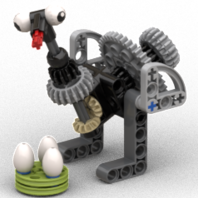
[MOC] Excavator. Single motor, fully functional.
McMarky posted a topic in LEGO Technic, Mindstorms, Model Team and Scale Modeling
Hello guys, Do you like oldschool Lego Technic with a single motor and many functions? I hope you would like my excavator. It has only a single PF L motor and is fully functional. It can drive and dig. Enjoy the show 😀 -
Wasn`t sure if i had to post this on the old thread or to make a new one, but I decided to be safe. Anyway, I recreated Jantayg`s buggy made for the BuWizz 2018 ”Fast car competition”, but, being a recreation not a copy, differs in some manners, such as the way the front frame is attached to the main chassis. This MOC has 1x buggy motor and 1x servo-motor, pneumatic shock absorbers, a good suspension travel and a space more than enough for the battery/ electronics but sticks to around 700g with 1x battery. You can find the digital construction file and the part lists for the other paint-jobs on Rebrickable Thanks to the original creator that accepted this recreation to be made public!
- 19 replies
-
- technic
- instructions
-
(and 3 more)
Tagged with:
-
This is an expansion, upgrade and update of the Tiger 4 x 4 x 4 The idea was to improve certain aspects of the 4x4 version: 1. The bewel gears were the weak part of the driveline, so the 6x6 uses additional 12:20 gearing after bewel gears, increasing available torque by 67% 2. Adding a second rear axle additonally helps to spread the load while climbing, increasing available overall torque by another 50%, allowing for a total of 2,5x more torque than 4x4. 3. Using defender wheels, and self-built hubs the pivot point is now a stud closer to the steering wheel and steering angle is increased from 18 to 25-30 degrees, removing the need for rear steering. 4. Center section was widened by 2 studs, allowing both gearboxes to be placed in parallel and the steering servo motor low in the center. Total gear reduction has been increased to 1:5 in high gear and 1:15 in low gear. Gear switching mechanism is now faster and more reliable. 5. Suspension is now pendular with a shock absorber in front and tandem axles with shock absorbes in the back. This allows the suspension to smoothly adjust to the terrain at slow speeds without wasting energy compressing the shock absorbers. At high speeds the shock aborbers smooth out the ride. In the picture below you can see the blue 1x7 beams which swing and allow the front suspension to act like pendular: 6. The model now has working fake engine(s) and steering wheel.I'm thinking of adding a hook arm with a winch in the back, so I can use this model to pull others out during trial truck races 7. Number of motors have been reduced by removing rear wheel steering and having one motor for the gearbox, allowing to add aditional functions as before mentioned hook arm. So...that's all about it for now, I'm only missing defender wheels to finish this monster. Yes it's going to be heavier and slower, but I expect it to be even more capable and reliable.
-
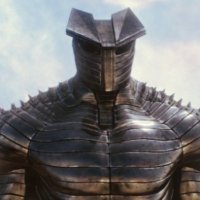
[MOC]◄Dodge Challenger 2008 SRT►[2021]
Michael217 posted a topic in LEGO Technic, Mindstorms, Model Team and Scale Modeling
Welcome to my garage LEGO!!! Hello! My name is Michael. I'm a Builder from Russia, I love muscle cars! Dodge Challenger 2008 SRT Hello everyone It's the first of August and I'm in a hurry to share with you another project! This time I collected the younger Dodge) And this is the third car of this brand in my garage! Description: - Drive - 1 Buggy motor - Steering - Servo - Nutrition-Small BB - Brain RC brik - Independent front suspension - Rear suspension bridge with four-point mounting - The steering wheel turns with wheels - Open the doors, hood, sunroof - Well-designed interior and under-hood space - About 2000 parts Instagram: https://www.instagram.com/lego_muscle_garage/ Join my group in VK: https://vk.com/legomusclegarage All photos on the link: https://bricksafe.com/pages/Michael217/dodge-challenger-2008-srt Enjoy your viewing! Rate, comment! Thanks!) -
Ahoi and may the force be with you, pirate! Finally I present to you the MOC by my friend Jan-Hendrik and me: The Pirate Death Star some may have seen it in person in Skaerbaek last autumn but now I had time to post it... The different Death Stars are a building project invented by my LUG Steinhanse, so every year there will be several crazy Death Stars! Video Levels The death star consists of 4 levels and a big cannon, as the original lego set. The levels are devided as follows: Level 0: Deep Sea with fish and all the different sea creatures The Kraken Atlantis and more Level 1: Caves and shipwreck: The caves of the islanders, full of treasures. The pirates tavern under the hideout, partly in the old shipwreck. The dungeon of the redcoats The shipwreck Level 2: Island: The beach of the islanders The pirates hideout The Shipwreck bay The redcoats fort Level 3: Battle at sea : Ironhook and his Renegade Runner Revamp fighting Governor Broadside. Captain Redbeards crew on a treasure hunt, as well firing the big cannon. The redcoats lighthouse. The story of the plug. The caves have accessible stairways to the island. At sea level a technic chain powerd by a motor moves the boats and fish around. The big cannon fires a "Death Star cannon ball" All around in pictures: Level 0: Level 1: Level 2: Level 3: So, I hope there are not to much not not to few pictures.... I am really looking forward to your comments and hopefully some of you have seen it in Skaerbaek! All the best! Adrian
- 22 replies
-
- death star
- pirates
-
(and 3 more)
Tagged with:
-
I finally did it, I've built a Volvo. It took me little more than a month to design, collect parts and build it, which is pretty short for my standards, I usually take (or loose) more time to fully complete a MOC of these proportions. The scale is, roughly, 1/20 and it has some functional features. Using LEGO power functions the vehicle can drive, steer, lift its 2nd drive axle, flash its beacon lights and operate the hooklift system. To be perfectly honest, not all of its features work the way I wanted them to work. The chassis was a bit small to incorporate all of these functions. I may design a new chassis at some point (more of that below) For me the highlight of this model is the cab really, getting the proportions of an FH right was a challenge, I had to make many compromises, choose the lesser of two evils. Of all truck brands, the Volvo just has the most complex design to replicate in the brick. But that is of course because a Volvo is the most pretty truck of them all after all. As I am employed at Volvo Trucks I simply had to build Volvo’s flagship. When Covid is over, I’ll drive it around the office landscape :). You may have noticed, the cab is not a square box, I spent a lot of time figuring out how to best approach the silhouette of the FH cab. It gets slightly more narrow higher up. The chassis is packed, I had to fit the battery box and two receivers in the cab, which is one of the reasons why there's no interior. Now, I'm sure some of you will most certainly have some suspicions about the feasibility of my hooklift system here... And they would be right! To be honest, the hooklift doesn't work all that well, lifting a container is a bit too much. It was only after I had completed the chassis that I learned about some sort of quality problem with those linear actuators I've used. But I think the fact that the very short leverage to rotate the hooklift may also have something to do with it. That of course was a consequence of the limited stroke of these actuators. This calls for the new longer actuators! ... However, that means I'll have to completely redesign the chassis... I have a couple of WIP pictures that I may share later. I hope you like it!
- 13 replies
-
- model team
- truck
-
(and 4 more)
Tagged with:
-
I again wanted to go big on this build. Like BIG. So I went 1:16 scale the best I could. I started with an existing design from a failed build. The plan is to have 2 PF-L motors for the drive, PF-XL for the boom, and PF-M for the rest. Please note that I'm almost done with the build, but I am making minor adjustments to the build to help with function and/or weight support. I will be posting here to "show my work" of sorts and get feedback. I have been busy catching up on other things and building the excavator. (not much free time for posting/commenting on here) This was the first version of the bottom: And the start of the upper: It was looking good, sort of, I had to redo all of it as I add the battery boxes and arms it had a weak structure and was "clunky" in functions. I have remade all of the above and will post more in the morning to not have too many pics in a single post.
-

Davejsp's Technic creations
BrisquesDesigns posted a topic in LEGO Technic, Mindstorms, Model Team and Scale Modeling
deleted- 28 replies
-
- remote-controlled
- powered up
-
(and 4 more)
Tagged with:
-

[MOC] 1:48 New York Central / Boston and Albany D-2a (1912 2-4-4T & 1928 2-6-6T)
Commander Wolf posted a topic in LEGO Train Tech
Hello Train Tech! I haven’t been here for a while, but I have been building trains! I recently came across an old thread on the Boston and Albany 4-6-6T suburban tank engine, and I saw a comment about its smaller sibling. Well, I am here to share not one, but two suburban tank engines, including the aforementioned 2-6-6T, which I still consider one of my best models to date. To make things as confusing as possible, the NYC called both of these engines D-2a, though not at the same time. The 1912 D-2a (2-4-4T) went out of service shortly before the 1928 D-2a (2-6-6T) changed names. Both engines can navigate all R40 geometry and are much more buildable and usable than my first suburban tank attempt, though the 2-4-4T has to use Powered Up due to size limitations. The two videos at the end go into more detail about each engine and build. -
Hello, folks! Without long introduction - here are all my brickheadz so far (more than half are new, others - you could see them, but they have been slightly reworked). Note for mobile users - there will be many pics to load for your device. All building instructions are free. I'll add some comments by the way, but pics should do better :) 1) Newlyweds - kinetic model Animation (it may take some time to load): What is love? Baby don't h.. Hm, that's not what should have been said :) This couple celebrates their marriage with great dance. By the way, almost 22000 ukrainian couples got married since the beginning of the war in Ukraine. Love and peace will win! This model is driven manually by rotating a gear in back of the stand and can be motorised if you connect any motor you have to it. Given that the stand, groom and bride are separate models that work together, you can re-insert the bride and groom to make them rotate in the range you want. It also means you can use this stand to make your own brickheads "dance" as long as they have similar structure (all internal mechanics). Free building instruction: Rebrickable 2) Ukrainians A brave cossack; his younger brother; beatiful girl - they all can be the symbols of Ukraine. Let's take a closer look: This brave cossack has an earring in the left ear. Years ago it meant he was the one and only son of his mother. He wears traditional cossack pants - "sharovary" and traditional shirt - "vishivanka". Also, his hairstyle is called "oseledets" or "chub". Animation: Young girl. She also wears traditional combination of jacket and an embroidered skirt. Her flower wreath with colored ribbons is a symbol of youth and girlhood. Animation: Baby cossack - a symbol of ukrainian kids. Animation: Free buiding instructions: Rebrickable 3) Iron man with glow effect Animation: To use him as a pocket defender or just as a nightlight - it's up to you) It's a rework of set #41604, if you already have it - that's at least 40% of needed parts. You can use any PF-compatible power source to make it glow (such as 8881, 88000, 8878 and others). Free building instruction: Rebrickable 4) Ghost rider with glow effect Animation (without a chain): When it's cold, when it's dark, when there is no hope... Here is our hero - he brings light, warmth and hope for better times! You can use any PF-compatible power source to make it glow (such as 8881, 88000, 8878 and others). Free building instruction: Rebrickable 5) Polar four It's not just a company of polar habitants - it's a family: dad, mom, son and a cute bear cub in a sweater that, I bet, behaves and is perceived as a second son :) Animation: Animation: Animation: Animation: Also, you can build a silmplier and less parts-hungry version of a bear cub (without embroidery on the sweater): Free building instructions: Rebrickable 6) Popeye the Sailor Animation: Give this guy a spinach - and he will do an impossible! Free building instructions: Rebrickable 7) Athlete Animation: For all the lovers of fitness, dark glasses and pants with stripes :) Free building instructions: Rebrickable 8) Wolverine Animation: Friendly, polite, gentleman - all this is not about him. Strong, incredibly hardy, an excellent fighter - that's him! Now he can be your personal Jesu... bodyguard! :) Free building instructions: Rebrickable 9) Batbaby Animation: I'm sure he will nicely fit into the Batman's universe. Free building instructions: Rebrickable 10) Antique warrior Animation: A brave warrior is ready to protect you! Free building instructions: Rebrickable 11) Lumberman Animation: This guy never worries about the thickness of logs and about your problems. Free building instructions: Rebrickable 12) Kitten Animation: This tiny kitty will love you at first sight! Free building instructions: Rebrickable 13) Kiddy Animation: Just don't take the steering wheel from him and he will be ok!) Free building instructions: Rebrickable 14) Lifesaver Animation: "Ok, I get it. Everything will be fine, don't worry!" - lifesaver. Free building instructions: Rebrickable 15) Buddy Animation: He's a good friend of mine. From now - yours too!) Free building instructions: Rebrickable 16) Leeloo Animation: Free building instructions: Rebrickable 17) Sheriff Animation: “Dude, did you do all this mess in this room? I have questions for you! ”- sheriff. Free building instructions: Rebrickable Thank you for your patience attention! :D
-

[MOD] 10269 Harley Davidson Fatboy Remote Controlled
Cyrix78 posted a topic in LEGO Technic, Mindstorms, Model Team and Scale Modeling
Full RC Conversion of 10269 Harley Davidson Fatboy After many hours of trial and error, broken bits and gray hair I have finally a working Remote Controlled Harley. And it actually works wery well and are not more fragile than the orginal set. My goal was to create a slower motorbike that you can play with in your living room, so self balancing was not an option as this requires high speed to work. My bike runs on "training wheels" all the time that leans at the same time as the handlebar stears. Have tried my best to hide the electronics an keep it as close looking as possible to the orginal set. Motorized wtih Buwizz/CaDa battery to save space and Power Functions motors. Youtube Video Instructions available at Rebrickable- 16 replies
-
I made the 2021 LEGO 76240 Batman Tumbler drive (again) and upgraded the looks to be more real. full remote controlled motorization (drive and steer) independend suspension (front: moving liftarms!) moving front armour plates as in movie retractable roof complete do-over of side armor plates: finaly polygons very close to the movie (not flat as LEGO did it) front gunner seat "hydraulics" finally as in movie winglets fixed on both ends now (no loose parts as from LEGO) Mind the Gap - closed that gap between the rear tires (i think in danish LEGO rhymes on lazy ;) Instructions on rebrickable: https://rebrickable.com/mocs/MOC-95123 I already did this with the 2014 version. Actually it was my first LEGO set in years. But I was never really happy with this. There were still too many flaws (as with the 2021 version) This time i wanted it to look more close to the original, finally. So I upgraded the armour and some other details a bit, to fix LEGO's little flaws. This is the LEGO Tumbler Batmobile, I always wanted.
- 3 replies
-
- remote controlled
- power functions
-
(and 4 more)
Tagged with:
-
Hello everyone, let me introduce my latest creation. Ever since I get 42093 corvette I had an idea to disassemble it and use all this parts to create something playable and offroad capable. This 1:15 model of legendary F-150 truck was made with Power Functions elements and Sbrick for future truck trial competion or just for indoor fun (because of the weight (1250 g) I think this is not very competitive truck). It was a long project for me because of time constraints so I had started it before LEGO release their bigger one. This model has 4WD transmission with 2 L-motors driving each axle separetly (driving ratio - 3,5:1), servo motor for steering. Front suspension is independent double wishbone, rear is live axle with panara link. The model has openable doors, sunroof, hood and tailgate. Instructions in pdf were made in Stud io (my first experience with this software so it took a long time). Link for instructions: https://reb.li/m/93403 Also I created some additional color options with available parts. I hope to add instructions for those and the video with the orignal orange one later.
-
FT's Technic corner - MAN TGS 6x4 with bucket gripper
functionalTechnic posted a topic in LEGO Technic, Mindstorms, Model Team and Scale Modeling
Hi everyone, Finally, I have finished a project which I was building since last September. It is the scale model of the Intrac 2011 snow blower which is/was often used in the swiss alps by the army and other communal parties. It was the aim to create another working snow blower after the success of the snow blower from last winter. The blower is powered by three buggy-motors which are all controlled by a separate Sbrick. Each track is driven by two PF XL motors. The snow blower shoot direction is controlled by two 9-volt micro motors and the height of the snow blower by one PF L motor. As power source I used two Buwizz as battery or a custom lipo battery. After a certain time in the cold I had the replace the Buwizz with the custom lipo battery. Cheers FT -

[MOC] Unimog 437
Thirdwigg posted a topic in LEGO Technic, Mindstorms, Model Team and Scale Modeling
I guess you could say I couldn't make up my mind about the kind of Unimog I wanted to make next. So I decided to make a platform that would support multiple versions. Features: Interchangeable platform Long and short wheelbase options Standard and Doka cabs, removable Manual control PF control (drop in) Front and rear suspension Steering 4x4 with I-4 fake motor Opening doors and hood Tipper bed options Feel free to check out thirdwigg.com to learn more about the build. Manual SWB with tipper bed. Manual LWB Doka with tipper bed. Power Functions (XL drive, Servo steering) LWB with cover. Manual LWB with canvas bed showing the suspension travel. You can find more pictures on my flickr. I have been adding instructions for the various versions here, and more will be added over the coming weeks. Someday I'll make a camper, because, everyone needs a camper. This was a fun project, and I loved the way it turned out. I have the LWB on my desk right now, and I keep getting distracted from work. I hope to add additional options for the system at some point, and will take other suggestions for versions to add. Hope you enjoy.- 28 replies
-
- instructions
- suspension
-
(and 3 more)
Tagged with:
-

Strange Power Functions Issue
jshuiting posted a topic in LEGO Technic, Mindstorms, Model Team and Scale Modeling
I bought a set from bricklink a while ago and tested out the electronics, only to find that they were acting really strange. I'll try to explain it is as clear as possible but i may mess up a bit. So the set came with 4 motors, one of each kind, XL, L, M and Servo, and these all work perfectly fine on my own battery packs and recievers. But now i hook them up to the included recievers, so XL on red, L on blue, but then only the XL motor works. Now i'll switch them arround, but yet again it's only the XL motor that works, but now on the red channel. The L motor does function correctly when hooked up to a different reciever or straight to a battery pack. Further testing shows the XL motor works on all my recievers, both red and blue channels. The L motor works on 2 out of 4 recievers but only on either red or blu side, not both sides on the same reciever The Servo motor worked on none. And the M motor worked on 3 out of 4, also on just one side per reciever, either red or blue. And again all the motors work directly on the battery pack, or when hooked up to known good reciever. So what's going on here? How does one motor work on a reciever, but another does not? Can i throw away the motors or are the recievers at fault here? It's really frustrating because i am in the midst of making a deal with the seller aswell, but i can't without knowing exactly what's broken. It's like the recievers are picky in which motors they want to actuate and which ones not, but how's that even possible?- 5 replies
-
- power functions
- electrics
-
(and 5 more)
Tagged with:
-
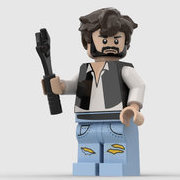
[Mod] RC Motorized Ghostbusters 10274 Ecto-1 with Powered Up
recklessGlitch posted a topic in LEGO Licensed
I got the Ecto for christmas and I felt the urge to squeeze in some remote controlled Motors. The new Powered Up have just the thing (although they are badly documented) One month after christmas I had it up and running. Tell me what you think. • quasi invisible • minimal invasive - all gadgets work • Battery replacement with no dissambling • light and sound kit still fits in • Lego POWERED UP Bluetooth Remote Control • no discontinued Power Functions • complete Instructions on rebrickable I made my first video about that: For this motorization I used LEGO's Powered Up Large Technic Motor for steering. That thing is just made to be used for the steering. It can act like a servo, because it has an internal position sensor. It is slim and dark bluish gray so it replaces that kardan drive below the front seat perfectly. Aditionally I didn't want to take it appart every time I change the batteries, so you can reacht it from the bottom.

